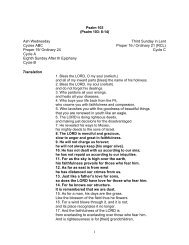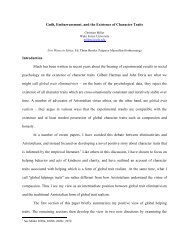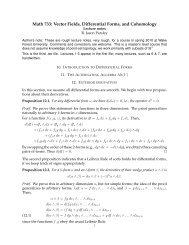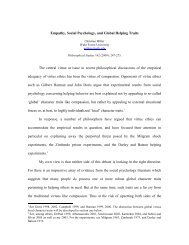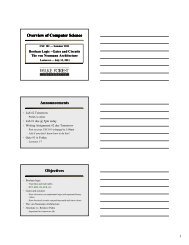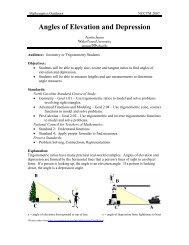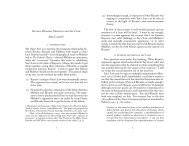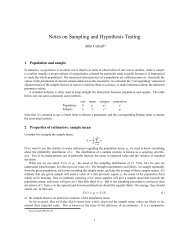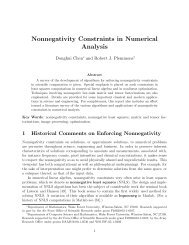Guilt and Helping - Wake Forest University
Guilt and Helping - Wake Forest University
Guilt and Helping - Wake Forest University
Create successful ePaper yourself
Turn your PDF publications into a flip-book with our unique Google optimized e-Paper software.
<strong>Guilt</strong> <strong>and</strong> <strong>Helping</strong>Christian Miller<strong>Wake</strong> <strong>Forest</strong> <strong>University</strong>millerc@wfu.eduAdvances in Psychology Research. Alex<strong>and</strong>ra Columbis (ed.). Volume 68.New York: Nova Science Publishers, 2010, 117-138.Reprinted in International Journal of Ethics 6:2/3 (2010): 231-252.IntroductionA wealth of research in social psychology over the past twenty years has examined therole that guilt plays in our mental lives. In this paper, I examine just one aspect of this vastliterature, namely the relationship between guilt <strong>and</strong> prosocial behavior. 1 Researchers havetypically found a robust positive correlation between feelings of guilt <strong>and</strong> helping, <strong>and</strong> haveadvanced psychological models to explain why guilt seems to have this effect. Here I presentsome of their results as well as draw out certain important implications that seem to follow formoral psychology <strong>and</strong> ethical theory.This paper is part of a much larger project aimed at studying various psychologicalvariables responsible for influencing helping behavior. In a number of recent papers, I haveexamined the effect of good <strong>and</strong> bad moods, empathy, audience inhibition, <strong>and</strong> embarrassmenton prosocial behavior (Miller 2009a, 2009b, 2009c, 2009d), <strong>and</strong> so towards the end of this paperI briefly attempt to integrate work on guilt into a larger picture of the psychology of helpingbehavior.Hence the paper will be structured as follows. Section one is devoted to characterizingthe emotion of guilt <strong>and</strong> distinguishing it from shame. Section two then provides an overview ofempirical work on guilt <strong>and</strong> prosocial behavior, followed by section three which attempts to1 Here I follow Estrada-Hollenbeck <strong>and</strong> Heatherton 1998 in underst<strong>and</strong>ing prosocial behavior as “actions that arevoluntary <strong>and</strong> that specifically benefit another person” (1998: 219). I typically treat „prosocial behavior‟ <strong>and</strong>„helping behavior‟ interchangeably.
draw out some philosophical consequences from that work. Finally, the fourth section of thepaper will incorporate the discussion of guilt into a larger framework for thinking about helping.1. Characterizing <strong>Guilt</strong>In treatments of guilt in the psychology literature, it is customary to find it listed underthe heading of a self-conscious emotion. 2 In contrast to more basic emotions such as anger, fear,<strong>and</strong> disgust, self-conscious emotions involve the self in their evaluations. More precisely, selfconsciousemotions typically involve an implicit awareness of normative st<strong>and</strong>ards, of the self‟sindividual responsibility for living up to those st<strong>and</strong>ards, <strong>and</strong> of the self‟s st<strong>and</strong>ing in relation tothose st<strong>and</strong>ards. Success or failure in living up to these norms can elicit guilt, shame, pride,<strong>and</strong>/or embarrassment, among other self-conscious emotions. 3Concerning the concept of guilt, we can start with the commonsense observation thattypically one feels guilt when (i) one performs an action (or omission) that violates one or moreof the agent‟s normative st<strong>and</strong>ards for behavior, (ii) those st<strong>and</strong>ards have some significant degreeof importance to the agent, <strong>and</strong> (iii) the action is such that the agent takes him or herself to bearsome personal responsibility for performing it in the first place. 4 For instance I periodically feel2 This paper is not concerned with legal guilt, where we say that a criminal is guilty of having broken the law.Rather, our focus is on the negative subjective experiences of guilt for actions we have performed that go against ournormative st<strong>and</strong>ards. For different uses of the term „guilt,‟ see Baumeister et al. 1994: 245.3 For more, see Caprara et al. 2001, Tangney et al. 2007a, 2007b, Tracy <strong>and</strong> Robins 2007, Basil et al. 2008,Menesini <strong>and</strong> Camodeca 2008, <strong>and</strong> Hosser et al. 2008.4 For similar claims see, e.g., Kugler <strong>and</strong> Jones 1992: 318, Baumeister et al. 1994: 245, Lindsay-Hartz et al. 1995,Eisenberg 2000: 667, Sinnott-Armstrong 2005: 199-202, <strong>and</strong> Basil et al. 2006. These are not offered as anything likestrict necessary conditions but rather as generalities. For instance, the phenomenon of collective guilt for the moralfailures of others does not fall neatly under heading (iii) (see Baumeister 1994: 251-2, Estrada-Hollenbeck <strong>and</strong>Heatherton 1998: 216, <strong>and</strong> Tangney et al. 2007a: 358-9, 2007b: 28. Sinnott-Armstrong (2005: 202) proposes a nicerevision to accommodate these cases.). Similarly, there is some evidence that guilt can arise just as strongly inresponse to accidental transgressions, which again is not in line with (iii) (Baumeister et al. 1994: 249). SeeBaumeister et al. 1994 for a thorough discussion of the complexities involved here.Nor are these conditions proposed as jointly sufficient. Some psychologists, for instance, stress the role ofpunishment in guilt (Kugler <strong>and</strong> Jones 1992: 325, Caprara 2001, <strong>and</strong> Zemack-Rugar et al. 2007: 929; for criticism- 2 -
guilt over not donating more money to famine relief because such an omission violates my moralnorms about which I care a great deal, <strong>and</strong> is an omission for which I am thoroughly responsible.When we are talking about guilt in this way, we are referring to a state of guilt, or an occurentfeeling of guilt which arises consequentially from the performance of a particular action, theformation of a certain intention, or the omission of a specific behavior. State guilt is to bedistinguished from the proneness to guilt or trait guilt, a disposition to experience a state of guiltin a wide variety of guilt-eliciting circumstances specific to that agent‟s normative st<strong>and</strong>ards. 5Given these familiar observations, how do psychologists go further <strong>and</strong> try to distinguishguilt from the other self-conscious emotions, <strong>and</strong> specifically from shame? Unfortunately there isno consensus in the literature, but three approaches can be quickly dismissed:(a) One approach is to distinguish guilt on the basis of the types of situations which elicit it.Unfortunately, studies have found that the very same situations involving lying, failing tohelp, stealing, <strong>and</strong> so forth can elicit guilt in some subjects <strong>and</strong> shame in others (<strong>and</strong> bothguilt <strong>and</strong> shame in still others). 6(b) Another approach is to claim that guilt is a more “private” emotion involving painfulfeelings of conscience, whereas shame is a more “public” emotion involving publicdisapproval. Again, though, the empirical data points in the other direction. Subjects havebeen found to experience both guilt <strong>and</strong> shame in public contexts, <strong>and</strong> shame can beexperienced in just as solitary <strong>and</strong> private a way as guilt. 7(c) A third approach claims that guilt is a strictly moral emotion, whereas shame arises inboth moral <strong>and</strong> nonmoral contexts. However, just our ordinary experience alone suggestssee Baumeister et al. 1994: 245). Others claim that regret over wrongdoing plays a central role (Kugler <strong>and</strong> Jones1992: 325 <strong>and</strong> Eisenberg 2000: 667).5 Compare Kugler <strong>and</strong> Jones 1992, Jones et al. 1995: 308, <strong>and</strong> Tangney et al. 2007a: 347, 2007b: 22.6 For discussion, see Tangney 1998:4, Eisenberg 2000: 668, <strong>and</strong> Tangney et al. 2007a: 348, 2007b: 25.7 See Tangney 1998: 4, Sinnott-Armstrong 2005: 201, <strong>and</strong> Tangney et al. 2007a: 348, 2007b: 25.- 3 -
(ii)Because of the connection to the self, shame can inspire feelings of helplessness <strong>and</strong> aninability to do anything about one‟s condition, whereas a similar connection has not beenfound with guilt. 11(iii) Closely related to the previous two consequences, shame tends to lead to avoidance of theshame-eliciting circumstances <strong>and</strong> more generally to social withdrawal, whereas guilttends to lead to a focus on the action <strong>and</strong> correlates positively with attempts atreparation. 12(iv) Both externalization of blame <strong>and</strong> feelings of anger have been positively correlated withtrait shame <strong>and</strong> occurent shame, with the externalized blame mediating the anger. Neitherhas been positively correlated with guilt. 13(v)Similarly by focusing on the self shame impedes empathetic feelings, whereas guilttypically has the opposite effect. 14(vi) Shame is typically considered to be the more painful of the two emotions, preciselybecause it is focused on the self rather than on just an instance of behavior. 15(vii) Proneness to shame has been correlated with a number of psychological deficits, such aslow self-esteem, depression, anxiety, <strong>and</strong> posttraumatic stress disorder. Indeed manypsychologists consider shame to be maladaptive. 16 The case of guilt is more complex. Onthe one h<strong>and</strong>, ordinary occurrences of guilty feelings which stem from a guilt11 Tangney 1998: 7, Bybee <strong>and</strong> Quiles 1998: 274, Caprara 2001: 221, Tangney et al. 2007a: 349, 353, Amodio et al.2007: 528, <strong>and</strong> Hosser et al. 2008: 139.12 Barrett 1995: 41, Tangney 1995: 119-120, 1998: 7-8, Estrada-Hollenbeck <strong>and</strong> Heatherton 1998: 216, Eisenberg2000: 668, Sinnott-Armstrong 2005: 201, Tangney et al. 2007a: 350, 2007b: 26, Menesini <strong>and</strong> Camodeca 2008: 184,<strong>and</strong> Hosser et al. 2008: 139.13 Tangney 1995: 120-129, 1998: 7, Lindsay-Hartz et al. 1995: 296, Eisenberg 2000: 669, Tangney et al. 2007a:351-2, 2007b: 27, <strong>and</strong> Hosser et al. 2008: 13914 Baumeister et al. 1994: 254-5, Tangney 1995: 129-133, Lindsay-Hartz et al. 1995: 296, Eisenberg 2000: 668,Manion 2002: 81, <strong>and</strong> Tangney et al. 2007a: 350, 2007b: 26-7.15 Tangney et al. 1992: 469, Tangney 1995: 117, 1998: 5, Eisenberg 2000: 667-8, Manion 2002: 77-78, Sinnott-Armstrong 2005: 201, <strong>and</strong> Tangney et al. 2007a: 349, 2007b: 26.16 See Tangney et al. 1992, 1995, 2007a, 2007b: 27. For cautionary notes about this claim, see Manion 2002 <strong>and</strong>Menesini <strong>and</strong> Camodeca 2008.- 5 -
predisposition have been found to correlate with lower hostility, reduced depression, <strong>and</strong>other signs of mental health. On the other h<strong>and</strong>, a recurring condition of chronic guiltwhich is detached from the immediate actions performed by the agent has been found tocorrelate positively with symptoms of depression <strong>and</strong> psychopathology. This has ledsome psychologists to distinguish between two distinct kinds of guilt, chronic <strong>and</strong>predispositional, <strong>and</strong> in the remainder of this paper our concern will only be with thelatter. 17(viii) As we will see in detail in the next section, guilt is positively correlated with subsequentprosocial behavior. In addition, it is worth noting that proneness to guilt is also related todeceases in the likelihood of problematic behaviors such as theft, drug abuse, unsafe sex,using risky needles, <strong>and</strong> inmates‟ post-release recidivism. Fewer such correlations havebeen found in the case of shame. 18Hence we have seen that guilt <strong>and</strong> shame are both self-conscious or regulative emotions, <strong>and</strong>they are both negatively valanced. They are concerned with moral norms, although notexclusively with such norms. And they can arise privately or publically in response to many ofthe same eliciting situations. But despite these similarities, we also see that these two emotionsare significantly different in a variety of respects. For the remainder of the paper, we shall setshame to one side, <strong>and</strong> focus only on guilt.2. <strong>Guilt</strong> <strong>and</strong> <strong>Helping</strong>17 For helpful discussion of these two kinds of guilt, see Estrada-Hollenbeck <strong>and</strong> Heatherton 1998: 224, Eisenberg2000: 669-70, <strong>and</strong> especially Quiles <strong>and</strong> Bybee 1997, Bybee <strong>and</strong> Quiles 1998. And for guilt <strong>and</strong> mental health ingeneral, see Tangney et al. 1992 <strong>and</strong> Tangney et al. 2007a: 351-354.18 Bybee <strong>and</strong> Quiles 1998: 270, Tangney et al. 2007a: 354-5, Hosser et al. 2008, <strong>and</strong> especially Stuewig <strong>and</strong>Tangney 2007. For cautionary notes about this claim, see Manion 2002 <strong>and</strong> Menesini <strong>and</strong> Camodeca 2008.- 6 -
Thus 55% of guilty subjects helped compared to only 15% of controls (44).In a similar experimental design, Konečni (1972) studied the behavior of subjects on thestreets of Toronto. In the guilt condition, the experimental confederate walked towards thesubject carrying three expensive-looking books. After absent-mindedly running into the subject<strong>and</strong> dropping the books, the confederate exclaimed, “They are not mine, <strong>and</strong> you have to do this”<strong>and</strong> walked away. Fifty to seventy five yards later, the subject came across another personwalking out of a doorway who had forty computer-punched cards drop out of a folder. Thisconfederate, while bending down to pick up the cards, said to the subject, “Please don‟t step onthem.” Control subjects did not have the guilt manipulation but just came across the confederate<strong>and</strong> the dropped cards. The helping variables were the number of subjects who collected cards<strong>and</strong> how many they collected, which came out as follows (32):% of subjects who collected cards Mean number of cards collectedControl 16 1.29<strong>Guilt</strong>y 42 4.77Once again we see a significant difference in helping behavior correlated with prior feelings ofguilt, provided that the guilt manipulation is effective in this case.Nor are these correlations limited to more mundane prosocial behavior. In a longitudinalstudy of six German prisons <strong>and</strong> 1,243 inmates, Hosser et al. (2008) examined the relationshipbetween guilt <strong>and</strong> shame on the one h<strong>and</strong>, <strong>and</strong> criminal convictions after release from prison onthe other. They found that twenty-four months after being released, 54.1% of inmates who feltguilt but no shame during imprisonment had no new convictions, compared to 39.7% of thosewho felt shame but no guilt (146).- 8 -
And robust correlations have been found not only between actual experiences of guilt <strong>and</strong>prosocial behavior, but also between anticipated guilt <strong>and</strong> such behavior. Lindsey (2005), forinstance, found a strong correlation between anticipated guilt over not helping those in need of alife-saving bone marrow donation, <strong>and</strong> both the intention to <strong>and</strong> actual compliance with requeststo be tested as a possible donor. 146 undergraduate students were brought into the lab twice with7-10 days in-between their visits. Subjects who were given a high anticipated guilt message hadcorrelations of .63 between the message <strong>and</strong> anticipated guilt, .84 between anticipated guilt <strong>and</strong>behavioral intent, <strong>and</strong> .42 between behavioral intent <strong>and</strong> actual behavior (469). 19At this point, it is important to note a complication. For while guilt seems to engenderprosocial behavior, it has also been associated with avoidance behavior in certain instances,especially with respect to inhibiting the very action which prompted the guilty feelings in thefirst place. 20 But as Amodio et al. (2007) argue, there need be no tension here between these twomotivational facets of guilt. On their view, the initial experience of guilt “functions to halt theinterpersonal damage being caused by the transgressive behavior” <strong>and</strong> to “survey the damage,<strong>and</strong> learn from mistakes” (525). <strong>Helping</strong> behavior, on the other h<strong>and</strong>, could be a subsequenteffect of guilty feelings aimed at promoting one or more of the motivational goals describedbelow. Amodio <strong>and</strong> his colleagues used electroencephalograph recordings of cortical activity tostudy racial prejudice <strong>and</strong> guilt reactions, <strong>and</strong> found empirical support for this proposal.The above only scratches the surface of the experimental work on guilt <strong>and</strong> prosocialbehavior – literally dozens of other studies show similar trends. 21 So let us accept a robust19 See also Basil et al. 2006 on anticipatory guilt <strong>and</strong> charitable donations.20 See Freedman et al. 1967, Baumeister et al. 1994: 258, <strong>and</strong> Amodio et al. 2007.21 See, e.g., Freedman et al. 1967, Carlsmith <strong>and</strong> Gross 1969, Donnerstein et al. 1975, Harris et al. 1975, Harris <strong>and</strong>Samerotte 1976, Cunningham et al. 1980, Baumeister et al. 1994: 257, Quiles <strong>and</strong> Bybee 1997, Estrada-Hollenbeck<strong>and</strong> Heatherton 1998, Zhong <strong>and</strong> Liljenquist 2006, <strong>and</strong> Basil et al. 2008. For a very helpful list of early studies, seeSalovey <strong>and</strong> Rosenhan 1989. Even subjects high in guilt proneness who were primed with subliminal guilt- 9 -
positive correlation for now, <strong>and</strong> indeed go further <strong>and</strong> claim that it is because subjects arefeeling guilty that they are exhibiting such behavior at higher rates than controls. Thus to use thefirst of several rough diagrams that will be employed in this paper, we have the following:<strong>Guilt</strong> over a Particular Perceived Wrongdoing↓Activation of <strong>Helping</strong> Mechanism↓<strong>Helping</strong> Behaviorwhere the arrow is intended to symbolize causal influence. Naturally it is assumed in thisdiagram that other things are being held equal since if, for instance, there are no opportunities toactually help, or if something else besides the feelings of guilt is much more psychologicallysalient at the moment, then we would not expect increased helping behavior to result.What psychological factors might best account for this relationship? More precisely, whatmotivational state(s) does guilt give rise to which in turn often fosters prosocial behavior? 22 Herethe literature in social psychology is much less helpful. For a number of incompatible proposalshave been offered, <strong>and</strong> in many cases with very little refinement or care in stating them. In theremainder of this section, I mention some of the leading c<strong>and</strong>idates:Desire to Repair the Specific Wrong. On this proposal, a state of guilt causes theformation of a desire to repair the specific perceived wrong performed by the agent, which inturn motivates helping behavior aimed at repairing the fault. Thus if I feel guilty for havingstolen something from you, this could lead to the direct formation of a desire to atone for thiswrong towards you in some way. There might be a variety of ways of doing so, such as makingadjectives helped more than both (i) similarly primed subjects who were low in guilt proneness <strong>and</strong> (ii) sadnessprimed subjects (Zemack-Rugar et al. 2007).It is important to stress again that these studies do not pertain to chronic guilt, which as noted in section oneis a different kind of guilt which would not be expected to correlate positively with prosocial behavior. See Quiles<strong>and</strong> Bybee 1997: 122.22 To simplify the discussion, in the remainder of the section I focus mainly on (i) consequential guilt uponperforming an action deemed wrong rather than anticipatory guilt, <strong>and</strong> (ii) states of guilt rather than guilt traits.- 10 -
financial compensation, buying a replacement item, <strong>and</strong> so forth. But it might turn out that thebest way I can see to be make restitution for this wrong is to help you in some significant way. Inthose cases, <strong>and</strong> holding other things equal, we would expect the agent to help at a significantlyhigher rate than otherwise. Diagrammatically we would have the following:<strong>Guilt</strong> over a Particular Perceived Wrongdoing↓Desire to Repair the Specific WrongPerceived <strong>Helping</strong> Task(s) → ↓ ← Absence of Other Means ofwhich Contributes toRepairing the Specific Wrong whichRepairing the Specific Wrongare Perceived to be More Effective↓Potential AdditionalMotives to Help→↓Activation of <strong>Helping</strong> Mechanism↓<strong>Helping</strong> BehaviorThus one consequence of this model would be that subjects who are experiencing guilt would nothelp at increased rates when the helping task would not have any connection to repairing thespecific wrong committed.Unfortunately, despite this model‟s simplicity <strong>and</strong> elegance, it is clearly too simplistic asstated. As we saw in Regan et al. (1972) above, 55% of guilty subjects helped compared to only15% of controls when it came to informing a confederate about the hole in her bag. This taskclearly had no bearing on atoning for the specific action of breaking the camera. Even morestriking is a series of experiments by Freedman et al. (1967). In one experiment, they had a roomarranged so that subjects would likely knock over the carefully arranged index cards of agraduate student in his office. Half of subjects in this guilt condition were later asked tovolunteer for an experiment by the same graduate student, whereas the other half were asked tovolunteer for an experiment run by an unrelated student. In general 75% of subjects whoknocked over the cards volunteered, whereas less than 39% of controls did. Strikingly, though, a- 11 -
significant difference emerged only for the request to assist the graduate student not connected tothe office or the cards (122). 23Desire to Repair Wrong-Doing as Such. The problem with this first model can be easilyaddressed if we switch from positing a desire to repair the specific wrong done, to a more generaldesire to repair the commission of a wrong as such. Manifestations of such a desire mightinclude confessing the wrong action, attempting to make adequate reparation, making amends insome other way if reparation to the one wronged is not possible, punishing the self, committingto refrain from such wrong actions in the future, pleading for forgiveness, offering some form ofpenance over <strong>and</strong> above reparation, <strong>and</strong> so forth. 24 Thus in the Regan study, by notifying theconfederate about the hole in her bag, subjects would be taking a step towards atoning for thefact that they earlier broke someone else‟s camera. The diagram for this model would have to beadjusted as follows:<strong>Guilt</strong> over a Particular Perceived Wrongdoing↓Desire to Repair Wrong-DoingPerceived <strong>Helping</strong> Task(s) → ↓ ← Absence of Other Means ofwhich Contributes toRepairing Wrong-Doing whichRepairing Wrong-Doingare Perceived to be More Effective↓Potential AdditionalMotives to Help→↓Activation of <strong>Helping</strong> Mechanism↓<strong>Helping</strong> Behavior23 An advocate of this first model could respond by positing a second desire to avoid confronting someone whom theagent has harmed. Indeed, Freedman et al. suggest this very possibility (123). However, this response would stillleave unexplained the host of studies like Regan et al. 1972 which show increased helping in unrelated subsequenttasks.See also Carlsmith <strong>and</strong> Gross 1969, who found that “guilt can lead to compliance even when there is noopportunity to make amends to the injured party” (238). Also relevant are Darlington <strong>and</strong> Macker 1966 <strong>and</strong> Harris<strong>and</strong> Samerotte 1976.24 See Lindsay-Hartz et al. 1995 for related discussion.- 12 -
Such a model would generate a number of testable predictions. One is that actions which serve toeliminate the agent‟s guilt without contributing in any way to repairing wrong-doing, should notsignificantly diminish subsequent helping behavior. Another is that whether a guilt-inducedsubject is independently experiencing positive affect (positive mood) should have little to nobearing on helping rates since the positive mood presumably would not satisfy the desire torepair the commission of a wrong.The above model seems to have a strong following in the literature on guilt <strong>and</strong> helping. 25At the same time, there seem to be a number of studies with results which are incompatible withthe above predictions. Let me briefly mention one study with respect to each prediction.Regarding the first, Zhong <strong>and</strong> Liljenquist (2006) asked subjects to recall an ethical or unethicalaction they performed in their past. Next subjects either used an antiseptic wipe to cleanse theirh<strong>and</strong>s or they did not. After completing a survey about their emotional state, they were given anopportunity to be an unpaid volunteer for a desperate graduate student in another research study.74% of subjects who did not use the wipes volunteered to help, whereas only 41% who did usethe wipes volunteered (1452). Note that the cleansing involved here was not a moral cleaningsuch as going to confession, which might be considered a means of trying to repair wrongdoing.26 Rather it was simply an act of physical cleansing for eliminating germs from theperson‟s h<strong>and</strong>s. Thus some subjects might have otherwise volunteered were it not for theirperformance of an action which had no bearing on repairing their prior unethical behavior, whichcontradicts what the above model should imply.Regarding the second prediction, Cunningham <strong>and</strong> colleagues (1980) examined therelationship between positive mood, guilt, <strong>and</strong> helping. Positive mood was manipulated by25 See, e.g., Freedman et al. 1967: 117, Baumeister et al. 1994: 257, Tangney 1995: 120, Amodio 2007, <strong>and</strong>especially Lindsay-Hartz et al. 1995.26 For the effect of confession on helping behavior, see Harris et al. 1975.- 13 -
having subjects find a free dime in the coin return slot of a pay phone. <strong>Guilt</strong> was manipulated byfollowing the broken camera technique developed by Regan et al. 1972. And the helping taskwas assisting a confederate pick up papers which had been dropped in front of the subject. Theresults were as follows (184):<strong>Guilt</strong>No <strong>Guilt</strong>Positive Mood 33% 73%No Positive Mood 80% 40%Hence whereas merely guilty subjects helped at much greater levels than controls, when subjectsfelt both guilty <strong>and</strong> in a positive mood, they did not. So contrary to the second prediction of thismodel, experiencing a positive mood does have an important bearing on helping behavioramongst individuals experiencing guilt.Desire to Improve One’s Own St<strong>and</strong>ing. The previous model posited a desire which isconcerned, not directly with the agent in question, but rather with morality itself <strong>and</strong> theimportance of repairing a failure to live up to the agent‟s moral st<strong>and</strong>ards. In order to helpexplain the relationship between guilt <strong>and</strong> helping, we could instead posit a desire that the agentmight have to improve his or her (actual or perceived) moral purity, worth, virtue, social image,social attachments, social <strong>and</strong> communal relationships, moral st<strong>and</strong>ing in the community, or thelike. 27 The diagram here would look like this:<strong>Guilt</strong> over a Particular Perceived Wrongdoing↓Desire to Improve One’s Own St<strong>and</strong>ingPerceived <strong>Helping</strong> Task(s) → ↓ ← Absence of Other Means ofwhich Contributes toImproving One’s St<strong>and</strong>ing whichImproving One’s St<strong>and</strong>ingare Perceived to be More Effective↓Potential Additional→27 See Carlsmith <strong>and</strong> Gross 1969: 239, Jones et al. 1995, Zhong <strong>and</strong> Liljenquist 2006, <strong>and</strong> especially Baumeister etal. 1994.- 14 -
Motives to Help↓Activation of <strong>Helping</strong> Mechanism↓<strong>Helping</strong> BehaviorNote that this model would generate some of the same predictions as the previous one: actionswhich eliminate guilt without improving moral or social st<strong>and</strong>ing should not significantlydiminish subsequent helping behavior, <strong>and</strong> since positive moods would not improve the agent‟sst<strong>and</strong>ing, they should have little bearing on helping rates. Thus the studies mentioned above astroublesome for the previous model should cause problems for this one as well. For instance,using antiseptic wipes has no bearing on one‟s actual or socially perceived st<strong>and</strong>ing, <strong>and</strong> yetserved to significantly reduce volunteering rates among guilty subjects. 28Desire to Alleviate One’s <strong>Guilt</strong>. The fourth <strong>and</strong> final motivational model to be mentionedhere holds that guilt states often cause the formation of a desire to eliminate or reduce the agent‟sguilt. Since helping is one very common way of making oneself feel better <strong>and</strong> no longer guiltyabout a prior wrong act, it is only to be expected that guilt would be positively correlated withhelping, other things being equal. On this picture then, helping is treated as an instrumentalmeans for promoting the agent‟s subjective well-being. Thus we get the following:<strong>Guilt</strong> over a Particular Perceived Wrongdoing↓Desire to Relieve <strong>Guilt</strong>Perceived <strong>Helping</strong> Task(s) → ↓ ← Absence of Other Means ofwhich Contributes toRelieving the <strong>Guilt</strong> whichRelieving the <strong>Guilt</strong>are Perceived to be More Effective↓Potential AdditionalMotives to Help→↓Activation of <strong>Helping</strong> Mechanism↓28 Advocates of this model could focus on certain specific variants of the desire to improve one‟s st<strong>and</strong>ing, such as adesire to restore one‟s moral purity, <strong>and</strong> argue that there is a psychological association between such a desire <strong>and</strong> adesire for physical cleansing. Thus by physically cleaning one‟s h<strong>and</strong>s, one is also in the process undergoing anindirect form of moral cleansing. See Zhong <strong>and</strong> Liljenquist 2006 for discussion.- 15 -
<strong>Helping</strong> BehaviorSuch a model would imply among other things that whether a person experiencing guilt helps isin significant part a function of whether the helping task would be more costly than the benefitderived from relieving the guilty feelings. 29Such a guilt relief model is perhaps the leading proposal in the psychology literaturetoday, 30 but even this view has met with some recalcitrant data. For instance, Zemack-Rugar <strong>and</strong>colleagues (2007) compared the helping behavior of subjects who were high in guilt-proneness<strong>and</strong> had been subliminally primed with guilt adjectives, with that of similarly primed subjectslow in guilt-proneness <strong>and</strong> also subjects primed with sadness adjectives. After the primingprocedure <strong>and</strong> emotion measures were administered by a computer, subjects were told of anotherstudy that involved “an array of annoying, boring, <strong>and</strong> repetitive tasks designed to assist a charityin formulating its research questionnaires.” Subjects were asked how much time (between 0-20minutes) they would like to volunteer to help the charity as unpaid volunteers. The initialexperiment was also cleverly rigged to supposedly last 60 minutes but proceeded quickly enoughso that subjects could volunteer for the entire 20 minutes if they wanted to without schedulingconflicts. The mean number of minutes volunteered was as follows (935):High guilt proneness, guilt prime:High guilt proneness, sadness prime:Low guilt proneness, guilt prime:Low guilt proneness, sadness prime:8.4 minutes3.9 minutes3.1 minutes2.2 minutesBut it is unclear why guilty subjects would be so much more inclined to be dedicated volunteersfor what seems to be a very costly task if helping behavior is being influenced by cost-benefit29 For related discussion, see Batson et al. 1986.30 See, e.g., Donnerstein et al. 1975, Cunningham et al. 1980, Baumeister et al. 1994:255-6, Quiles <strong>and</strong> Bybee 1997:104, Estrada-Hollenbeck <strong>and</strong> Heatherton 1998: 221, <strong>and</strong> Lindsey 2005.- 16 -
assessments pertaining to guilt relief <strong>and</strong> there will likely be plenty of subsequent opportunitiesavailable to relieve guilt in other ways. 31Let me conclude this section with some comments about these models. First, they clearlyeach need to be more carefully developed than has been done above, although even thispresentation is more detailed than one typically finds. Furthermore, each of the models is reallyjust a label for a family of closely related proposals. For instance under the heading of the desireto improve the agent‟s st<strong>and</strong>ing, we can distinguish a desire to improve the agent‟s actual moralst<strong>and</strong>ing given the agent‟s personal set of norms, versus a desire to improve the agent‟s sociallyperceived moral st<strong>and</strong>ing. Clearly these two desires could lead to the performance of differentactions in certain cases. In addition, while recalcitrant empirical results were mentioned for eachof the four models, they should not be taken as decisive problems but rather as initial concerns.And finally, these models need not be regarded as exclusive – it might turn out that some agentsinstantiate one of these kinds of desires whereas others instantiate another kind, <strong>and</strong> it mighteven be the case that some agents instantiate two or more of these desires at the same time whenfeeling guilty.3. Broader Implications of the Relationship between <strong>Guilt</strong> <strong>and</strong> <strong>Helping</strong>Despite this admittedly quick overview of the psychology literature on guilt <strong>and</strong> prosocialbehavior, we are in a position to draw a number of consequences which should be of particularinterest to those working on moral psychology <strong>and</strong> ethical theory. Then in the following sectionwe can integrate these consequences into a larger framework for thinking about what explains<strong>and</strong> predicts prosocial behavior.31 For another study involving guilt <strong>and</strong> an unpleasant helping task, see Darlington <strong>and</strong> Macker 1966. For criticaldiscussion of this fourth model, see Zemack-Rugar et al. 2007: 934 <strong>and</strong> especially Lindsay-Hartz et al. 1995.- 17 -
(a) The default state for most human beings is to not help. Recall that control subjectsalmost never helped in the studies mentioned above. Regan et al. (1972) had only 16% ofcontrols notify a woman that her bag was leaking c<strong>and</strong>y, <strong>and</strong> Konečni (1972) found that only15% of controls would stop to help pick up dropped cards. This would not be surprising if thehelping tasks were very dem<strong>and</strong>ing or time consuming. But note how trivial these tasks are, aresult which is consistent with the behavior of control subjects in a variety of studies on othervariables associated with helping such as good moods, bad moods, <strong>and</strong> empathy. 32 Indeed, notonly do many control subjects not help, an omission which itself is often morally problematic,but they often go further than that. For instance in the Konečni study, “the control subjectstended to make a fairly large <strong>and</strong> unnecessary semicircle around the pile of cards, <strong>and</strong> hardlyever commented on what had happened” (1972: 32).Thus the first implication is that, apart from the boost provided by guilt or one of theother motivational variables such as a good mood which will be mentioned in the next section,most people tend to not exhibit helping behavior even with respect to simple helping tasks.(b) <strong>Guilt</strong> influenced helping seems to be cross-situationally consistent. While theexperimental literature on guilt <strong>and</strong> helping has involved a wide variety of guilt-elicitingcircumstances (such as giving electric shocks, breaking a camera, <strong>and</strong> knocking over books) aswell as helping opportunities (such as picking up dropped cards, volunteering for an experiment,<strong>and</strong> notifying someone about a torn bag), a remarkably consistent pattern has emerged thatsubjects experiencing guilt help at higher levels than do subjects who do not, other things beingequal. We have every reason to expect this trend to continue in future experiments involving new32 See my 2009c <strong>and</strong> 2009d for an overview of these studies.- 18 -
guilt-eliciting circumstances <strong>and</strong> helping tasks. Thus there is a remarkable degree of crosssituationalconsistency in the experimental results.This consistency allows up to make what should be fairly accurate predictions about thehelping behavior of individuals experiencing guilt. Or rather, such would be the case once wehave a better idea as to what the correct model is of the motivational state(s) which mediatesguilt <strong>and</strong> helping. For as we saw above, each of these models makes different predictions aboutwhat helping tasks a person feeling guilty would likely perform. So just for the sake ofsimplifying the discussion, let us assume that the fourth, guilt-relief model is correct. Then wecan formulate conditionals which attempt to accurately capture certain trends in helping behavior.Here are two such conditionals based on the guilt-relief model:(C1) Other things being equal, if an agent is not experiencing guilt as a result of some perceived wrongthe agent has committed, <strong>and</strong>:(i) Is presented with a helping opportunity.(ii) Takes himself to be able to perform the helping task.that agent will probably not attempt to perform the helping task.(C2) Other things being equal, if an agent is experiencing guilt as a result of some perceived wrong theagent has committed, <strong>and</strong>:(i) Is presented with a helping opportunity.(ii) Takes himself to be able to perform the helping task.(iii) Takes the benefits of helping in terms of guilt relief to outweigh the perceived costsassociated with helping.(iv) Does not take there to be any more effective means available for relieving the guilt.that agent will probably attempt to perform the helping task.Note that the consequents of the conditionals are stated in terms of what the agent will“probably” do – none of the studies showed that all of the subjects in the guilt condition helped,just as none of them showed that all of the subjects in the control condition did not help. So theclaim is not that each individual will always try to perform some helping task when experiencingguilt <strong>and</strong> when the conditions in (C2) obtain. Rather, what we would expect to find if wemonitored that person‟s behavior <strong>and</strong> guilt levels over time is a significant difference in the- 19 -
frequency of his helping versus not helping which positively correlates with his experiences ofguilt, other things being equal.Unfortunately, while we have a wealth of data on how different individuals react toparticular helping opportunities when feeling guilty, what we do not have is a number oflongitudinal studies focused on the same individuals as they experience guilt on multipleoccasions <strong>and</strong> are confronted with various opportunities to help. So we can only speculate at thispoint that the same helping trends we see across subjects involved in the same experiment, willalso apply with the same subjects over time.(c) <strong>Guilt</strong>-produced motivation to help is not altruistic. Genuine altruistic motivation toperform an action is motivation concerned with the good of another person, independently ofwhether the action will directly benefit the agent or not. While it used to be popular to think thatthere is no such motivation, the tide seems to be shifting. More specifically, over the course ofthe past thirty years Batson <strong>and</strong> his colleagues have provided a wealth of experimental evidencefor the empathy-altruism hypothesis, or the claim that “empathy evokes motivation directedtoward the ultimate goal of reducing the needy person‟s suffering; the more empathy felt for aperson in need, the more altruistic motivation to have that need reduced” (2002: 92). 33 However,what might be true of empathy-influenced helping behavior, does not seem to hold for themotivational contribution that guilt makes. Take again our four models from the previous section.The first two involve moralistic motivation:Desire to Repair the Specific Wrong.Desire to Repair Wrong-Doing as Such.33 For reviews, see Batson 1987, 1991, 2002, <strong>and</strong> Batson et al. 2003 as well as my 2009d.- 20 -
In both cases, the primary concern is with what morality dem<strong>and</strong>s, rather than with, say, theinterests of someone in need. To the extent to which it stems from such a desire, helping theother person is thereby treated as instrumental to satisfying normative st<strong>and</strong>ards, <strong>and</strong> so is notgenuinely altruistic action.Similarly, recall that the other two models of guilt-produced motivation were thefollowing:Desire to Improve One’s Own St<strong>and</strong>ing.Desire to Alleviate One’s <strong>Guilt</strong>.And these are egoistic desires. If they give rise to helping behavior, then a person in need isbeing treated as a means to achieving one of these goals that the agent has. So in having such adesire, the agent does not really care about the person in need for his or her own sake, <strong>and</strong> indeedwould not even help in the first place if another, more attractive means of achieving the desirewere available.The upshot then is the following. If one or more of the four leading models of guiltproducedmotivation to help is correct, then the action which results will not be altruistic to theextent that it depends on such motivation. Furthermore, while it is still a good thing in most casesthat the person helps, we might conclude that the helper‟s action deserves no moral worth. Thisis plausible in the case of egoistic motivation such as a desire to alleviate one‟s guilt; to adaptMichael Stocker‟s famous example, if you are in the hospital <strong>and</strong> find out that your best friendhas come to visit you in order to alleviate her guilt, then while you are glad that your friend isvisiting, her action deserves no moral worth whatsoever. Indeed, it calls into question the extentto which she really is your best friend (Stocker 1976).- 21 -
In my view, the same is true in the case of moralistic motivation, although as we knowfrom Kant‟s famous discussion of moral worth in the Groundwork, here the issues are muchmore complex <strong>and</strong> unfortunately there is not adequate space to investigate them here. Let meonly note that if your friend comes to visit due in large part to a desire to repair the moraldamage done by a series of wrongdoings that she had performed towards someone else earlier inthe day, such an action does not show any special attachment towards you <strong>and</strong> is likely to strikemany people as cold <strong>and</strong> impersonal. Thus, not only it is not clear that guilt-produced motivationto help is altruistic, it is also not clear that it bestows on the action any significant degree ofmoral worth.(d) Most people do not possession compassion. In light of the first three implications, wecan arrive at the final conclusion of this section, namely that other things being equal, mostpeople do not have the virtue of compassion. To see this, consider the following familiar claimsabout what a virtuous person with the character trait of compassion would be like:(i)(ii)(iii)A person who is compassionate will, other things being equal, typically perform simple <strong>and</strong>straightforward helping tasks when in helping-relevant circumstances.A compassionate person‟s helping behavior which arises solely from his or her trait ofcompassion will, other things being equal, not be dependent on the presence of morallyproblematic or morally insignificant factors such as whether he or she is feeling guilty or not.A compassionate person who helps someone solely out of his or her trait of compassion, otherthings being equal, always does so for morally admirable reasons <strong>and</strong> motives.For example, we would expect a compassionate person to help pick up dropped computer cards,to do so regardless of whether she is feeling guilty or not, <strong>and</strong> to do so for virtuous motives. Onthe other h<strong>and</strong>, we have seen that the following claims appear to in fact be true:(i*)Most people will, other things being equal, typically not perform simple <strong>and</strong> straightforwardhelping tasks when in helping-relevant circumstances.- 22 -
(ii*) The helping behavior of a person will, other things being equal, often be dependent on thepresence of morally problematic or morally insignificant factors such as whether he or she isfeeling guilty or not.(iii*) A person who helps someone primarily out of a guilt-produced motive, other things being equal,often does not do so for morally admirable reasons <strong>and</strong> motives.Thus a person might often not help pick up dropped computer cards, <strong>and</strong> even when he does help,he might do so as a result of feeling guilty, thereby making the helping behavior at least partiallyif not entirely dependent on morally suspect motives like a desire to eliminate his guilt.One qualification should be noted here. Researchers have repeatedly found a positivecorrelation between guilt <strong>and</strong> empathy. If it turns out that (i) by focusing the agent on the harmcaused to others by his or her wrong action, feelings of guilt will in some instances give rise toempathetic feelings for another‟s suffering or misfortune, <strong>and</strong> if (ii) Batson‟s empathy-altruismhypothesis is correct, then motivation to help which arises from empathy for the other person‟ssituation, rather than directly from one of the four guilt-produced desires in section two, wouldtypically be altruistic <strong>and</strong> so be compatible with compassionate motivation. But even here it isunlikely that all cases of guilt-influenced helping are mediated by empathy, rather than just some.And even if all were, that would still not call into question claims (i*) <strong>and</strong> (ii*) above. 34Having said this, the experimental data on guilt <strong>and</strong> helping is compatible with theexistence of a few people who might have the virtue of compassion to some degree. Recall that15% of controls still stopped to help pick up the computer cards in Konečni‟s study, <strong>and</strong> 16% ofcontrols called attention to the torn bag in Regan‟s study. Indeed the existence of a few, ratherthan many compassionate people might be just what we would expect given our ordinaryexperience of the world <strong>and</strong> the course of human history.4. Integrating <strong>Guilt</strong> into a Broader Picture of <strong>Helping</strong> Behavior34 For more on guilt <strong>and</strong> empathy, see Tangney 1995: 131-133 <strong>and</strong> Tangney et al. 2007a: 350-351.- 23 -
Thus far in this paper, we have examined a number of issues associated with theempirical literature on guilt <strong>and</strong> helping. But that literature is only one part of a vastly largerbody of work in social psychology on various psychological variables which have beenpositively or negatively correlated with helping behavior. Positive correlations have also beenfound, for instance, with empathy, good moods, <strong>and</strong> certain instances of bad moods, whereasnegative correlations have been found with anger, fear of embarrassment, <strong>and</strong> fear of beingblamed. So let me end this paper with a much more speculative discussion of how these variables– guilt among them – might be incorporated into a broader picture of helping behavior. 35The place to begin, in my view, is with the idea of what I call “global helping traits”(GHTs), which I have explored in a number of recent papers. 36 GHTs are dispositions to try tohelp whose activity is sensitive to a number of different “triggers,” one of which, not surprisingly,is guilt. The presence of one of these triggers, other things being equal, increases the probabilitythat the agent will attempt to help when in situations where helping opportunities are thought tobe available. Diagrammatically, the picture is as follows:Appropriate Trigger is Activated↓Formation of a Motive which, given the Agent’s Background Beliefs, is Relevant to His or Her <strong>Helping</strong>↓Activation of a Global <strong>Helping</strong> Trait↓<strong>Helping</strong> BehaviorFor example, we saw that the trigger of guilt might lead to the formation of a motive to eliminatethe guilt, depending on whether the fourth mediation model of guilt <strong>and</strong> helping behavior turnsout to be correct. Given the agent‟s background beliefs that helping is a means of relieving guilt35 This section draws in part on my 2009a.36 Miller 2009a, 2009b, 2009c, 2009d.- 24 -
<strong>and</strong> that the agent is in a position to help certain people, this motive could activate the relevantGHT which in turn leads to the agent‟s trying to do so.In addition to guilt, the past forty years of research in social psychology have shown thathelping behavior is remarkably sensitive to the following psychological factors (among others):Embarrassment. 37Moderately Good Moods. 38Empathy. 39These other triggers can lead to the formation of quite different motives of their own, such as amotive to promote the well-being of another person in the case of empathy or a motive tomaintain a good mood in the case of positive affect. Such motives in turn might be just aseffective as the motive to eliminate guilt in leading to helping behavior.But what exactly is the contribution that GHTs are supposed to make to a story abouthelping behavior? I take GHTs to st<strong>and</strong> for certain clusters of mental states – beliefs, desires,intentions, <strong>and</strong> the like – which in many cases play a causal role in bridging the gap between thepresence of a trigger on the one h<strong>and</strong>, <strong>and</strong> elevated or reduced helping behavior on the other. Letme elaborate by returning to guilt <strong>and</strong> helping. We said that guilty feelings can give rise to amotive to relieve those feelings (again, provided that the fourth mediation model turns out to becorrect). An agent with a GHT will have a cluster of mental states related to helping <strong>and</strong> guilt.These might include:Beliefs about the relationship between helping others <strong>and</strong> various personal costs, such as lost time,money, alternative activities, <strong>and</strong> so on.Beliefs about the relationship between helping others <strong>and</strong> various social reactions, such as moralapproval, gratitude, praise, <strong>and</strong> so forth.Beliefs about the relationship between helping others <strong>and</strong> various moral consequences, such asliving up to the agent‟s norms, improving one‟s moral st<strong>and</strong>ing <strong>and</strong> purity, <strong>and</strong> so forth.Beliefs about how these various personal costs, social reactions, <strong>and</strong> moral consequencescontribute towards alleviating the agent‟s guilty feelings.37 Apsler 1975.38 Isen 1987, Carlson, Charlin, <strong>and</strong> Miller 1988, <strong>and</strong> Schaller <strong>and</strong> Cialdini 1990.39 Batson 1987, 1991, 2002, <strong>and</strong> Batson et al. 2003.- 25 -
A motive to help when doing so will contribute towards alleviating the guilty feelings, <strong>and</strong> amotive to not help when doing so will perpetuate or worsen the guilty feelings.Thus the agent might have a motive to relieve his guilt, <strong>and</strong> a belief that a helping opportunity isavailable. The first three sets of beliefs might lead him to an implicit judgment about what socialreactions, moral consequences, <strong>and</strong> personal costs might ensue if he actually helped. And thefourth set of beliefs might lead him to connect these various consequences to alleviating his guilt.Finally, the result of this (largely unconscious or automatic) collective evaluation might bring tobear a motive to help or to not help in connection with relieving the agent‟s guilty feelings. Forexample, if the helping task is very costly for the agent <strong>and</strong> outweighs the perceived benefits forguilt relief, this might lead to the formation of a motive to not help because helping might bethought to do nothing towards alleviating the guilty feelings.On my view, the default condition for most people with GHTs is that none of theappropriate triggers is typically present, <strong>and</strong> that frequently a GHT is not activated even inhelping-relevant circumstances. As we have already seen, this claim appears to be in line withexperiments in social psychology on helping behavior in which, for many helping tasks, only asmall percentage of control subjects seems to attempt to help. However, when activated in one ofthe relevant ways, <strong>and</strong> other things being equal, GHTs should lead a person to try to help both ina wide variety of circumstances <strong>and</strong> in repeated instances of the same circumstance. At the sametime, we would expect such continued helping behavior to be performed provided that themotive which led to the GHT‟s being triggered is still present at a suitable strength. To take thesame example, the motive to relieve guilt can trigger a GHT which in turn motivates severalinstances of helping behavior. But if such behavior is actually successful at relieving the guilt,then we would expect the helping behavior to dissipate.- 26 -
As character traits which are alleged to be widely possessed, GHTs are meant to play arobust explanatory <strong>and</strong> predictive role. Concerning the latter, they allow us to formulateconditionals which can offer fairly precise, testable empirical predictions for helping behavior.Indeed, we have already seen examples of such conditionals in the previous section with (C1)<strong>and</strong> (C2), <strong>and</strong> here is a third example for moderately good moods:(a)If an adult possesses a GHT <strong>and</strong> is experiencing intermediate levels of increased positive affect,that person will probably engage in helping-relevant behavior in moderate helping-relevantcircumstances.The „moderate‟ qualifier in the consequent is intended to exclude what are taken by the agent tobe extremely dem<strong>and</strong>ing acts of assistance, which we can predict are not likely to be performedvery frequently. Similarly for a trigger like empathy:(b)If an adult possesses a GHT <strong>and</strong> is experiencing intermediate levels of increased empathy, thatperson will probably engage in helping-relevant behavior in moderate helping-relevantcircumstances.However, if no inputs are present to trigger a GHT, then:(c)If an adult possesses a GHT which has not been triggered, that person will probably not engage inhelping-relevant behavior in moderate helping-relevant circumstances.Once again it is assumed that various other relevant considerations are being held equal, i.e., thatthe person is not also experiencing depression or an intense emotion like anger or fear.5. ConclusionMuch more could be said about GHTs, <strong>and</strong> I have done so elsewhere. 40 As far as thispaper is concerned, I hope to have provided a helpful overview of experimental work on guilt<strong>and</strong> helping behavior. In addition, I aimed to use the existing research to call attention to acentral area where further conceptual <strong>and</strong> experimental work needs to be done concerning the40 See my 2009a, 2009b, 2009c, <strong>and</strong> 2009d. In particular, in my 2009a I explore how GHTs can not only betriggered but also inhibited by, for instance, fear of embarrassment.- 27 -
motivating state(s) that mediates guilt <strong>and</strong> helping behavior. Furthermore, I attempted to drawsome interesting implications from the existing research, culminating in the conclusion that mostpeople do not have the virtue of compassion. At the same time, though, there is initial reason tothink that most people do have an alternative character trait instead, namely one or more GHTswhich are sensitive not only to feelings of guilt, but also to other psychological factors such asempathy <strong>and</strong> mood. Clearly there is much exciting empirical <strong>and</strong> philosophical work left to bedone in this area. 4141 This paper is a shorter version of my 2009b, which in addition to guilt also examines the relationship betweenembarrassment <strong>and</strong> helping.- 28 -
ReferencesAmodio, D., P. Devine, <strong>and</strong> E. Harmon-Jones. (2007). A Dynamic Model of <strong>Guilt</strong>: Implicationsfor Motivation <strong>and</strong> Self-Regulation in the Context of Prejudice. Psychological Science,18, 524-530.Apsler, R. (1975). Effects of Embarrassment on Behavior Toward Others. Journal of Personality<strong>and</strong> Social Psychology, 32: 145-153.Barrett, K. (1995). A Functionalist Approach to Shame <strong>and</strong> <strong>Guilt</strong>. In J. Tangney <strong>and</strong> K. Fischer(Eds.), Self-Conscious Emotions: The Psychology of Shame, <strong>Guilt</strong>, Embarrassment, <strong>and</strong>Pride (25-63). New York: The Guilford Press.Basil, D., N. Ridgway, <strong>and</strong> M. Basil. (2006). <strong>Guilt</strong> Appeals: The Mediating Effect ofResponsibility. Psychology & Marketing, 23, 1035-1054.Batson, C. (1987). Prosocial Motivation: Is it Ever Truly Altruistic? In L. Berkowitz (Ed.),Advances in Experimental Social Psychology (Vol. 20, 65-122). San Diego: AcademicPress.________. (1991). The Altruism Question: Toward a Social-Psychological Answer. Hillsdale:Erlbaum.________. (2002). Addressing the Altruism Question Experimentally. In S. Post, L. Underwood,J. Schloss, <strong>and</strong> W. Hurlbut (Eds.), Altruism & Altruistic Love: Science, Philosophy, &Religion in Dialogue (89-105). Oxford: Oxford <strong>University</strong> Press.Batson, C., M. Bolen, J. Cross, <strong>and</strong> H. Neuringer-Benefiel. (1986). Where is the Altruism in theAltruistic Personality? Journal of Personality <strong>and</strong> Social Psychology, 50, 212-220.Batson, C., J. Batson, C. Griffitt, S. Barrientos, J. Br<strong>and</strong>t, P. Sprengelmeyer, <strong>and</strong> M. Bayly.(1989). Negative-State Relief <strong>and</strong> the Empathy-Altruism Hypothesis. Journal ofPersonality <strong>and</strong> Social Psychology, 56, 922-933.Batson, C., P. van Lange, N. Ahmad, <strong>and</strong> D. Lishner. (2003). Altruism <strong>and</strong> <strong>Helping</strong> Behavior. InM. Hogg <strong>and</strong> J. Cooper (Eds.), The Sage H<strong>and</strong>book of Social Psychology (279-295).London: Sage Publications.Baumeister, R., A. Stillwell, <strong>and</strong> T. Heatherton. (1994). <strong>Guilt</strong>: An Interpersonal Approach.Psychological Bulletin, 115, 243-267.Bybee, J. <strong>and</strong> Z. Quiles. (1998). <strong>Guilt</strong> <strong>and</strong> Mental Health. In J. Bybee (Ed.), <strong>Guilt</strong> <strong>and</strong> Children(269-291). San Diego: Academic Press.Caprara, G., C. Barbaranelli, C. Pastorelli, I. Cermak, <strong>and</strong> S. Rosza. (2001). Facing <strong>Guilt</strong>: Roleof Negative Affectivity, Need for Reparation, <strong>and</strong> Fear of Punishment in Leading toProsocial Behaviour <strong>and</strong> Aggression. European Journal of Personality, 15, 219-237.Carlsmith, J. M. <strong>and</strong> A. Gross. (1969). Some Effects of <strong>Guilt</strong> on Compliance. Journal ofPersonality <strong>and</strong> Social Psychology, 11, 232-239.Carlson, M., V. Charlin, <strong>and</strong> N. Miller. (1988). Positive Mood <strong>and</strong> <strong>Helping</strong> Behavior: A Test ofSix Hypotheses. Journal of Personality <strong>and</strong> Social Psychology, 55, 211-229.Cunningham, M., J. Steinberg, <strong>and</strong> R. Grev. (1980). Wanting to <strong>and</strong> Having to Help: SeparateMotivations for Positive Mood <strong>and</strong> <strong>Guilt</strong>-Induced <strong>Helping</strong>. Journal of Personality <strong>and</strong>Social Psychology, 38, 181-192.- 29 -
Darlington, R. <strong>and</strong> C. Macker. (1966). Displacement of <strong>Guilt</strong>-Produced Altruistic Behavior.Journal of Personality <strong>and</strong> Social Psychology, 4, 442-443.Donnerstein, E., M. Donnerstein, <strong>and</strong> G. Munger. (1975). <strong>Helping</strong> Behavior as a Function ofPictorially Induced Moods. Journal of Social Psychology, 97, 221-225.Eisenberg, N. (2000). Emotion, Regulation, <strong>and</strong> Moral Development. Annual Review ofPsychology, 51, 665-697.Estrada-Hollenbeck, M. <strong>and</strong> T. Heatherton. (1998). Avoiding <strong>and</strong> Alleviating <strong>Guilt</strong> throughProsocial Behavior. In J. Bybee (Ed.), <strong>Guilt</strong> <strong>and</strong> Children (215-231). San Diego:Academic Press.Freedman, J., S. Wallington, <strong>and</strong> E. Bless. (1967). Compliance without Pressure: The Effect of<strong>Guilt</strong>. Journal of Personality <strong>and</strong> Social Psychology, 7, 117-124.Harris, M., S. Benson, <strong>and</strong> C. Hall. (1975). The Effects of Confession on Altruism. The Journalof Social Psychology, 96, 187-192.Harris, M. <strong>and</strong> G. Samerotte. (1976). The Effects of Actual <strong>and</strong> Attempted Theft, Need, <strong>and</strong> aPrevious Favor on Altruism. The Journal of Social Psychology, 99, 193-202.Hosser, D., M. Windzio, <strong>and</strong> W. Greve. (2008). <strong>Guilt</strong> <strong>and</strong> Shame as Predictors of Recidivism: ALongitudinal Study with Young Prisoners. Criminal Justice <strong>and</strong> Behavior, 35, 138-152.Isen, A. (1987). Positive Affect, Cognitive Processes, <strong>and</strong> Social Behavior. In L. Berkowitz (Ed.),Advances in Experimental Social Psychology (203-254). San Diego: Academic Press.Jones, W., K. Kugler, <strong>and</strong> P. Adams. (1995). You Always Hurt the One You Love: <strong>Guilt</strong> <strong>and</strong>Transgressions against Relationship Partners. In J. Tangney <strong>and</strong> K. Fischer (Eds.), Self-Conscious Emotions: The Psychology of Shame, <strong>Guilt</strong>, Embarrassment, <strong>and</strong> Pride (301-321). New York: The Guilford Press.Konečni, V. (1972). Some Effects of <strong>Guilt</strong> on Compliance: A Field Replication. Journal ofPersonality <strong>and</strong> Social Psychology, 23, 30-32.Kugler, K. <strong>and</strong> W. Jones. (1992). On Conceptualizing <strong>and</strong> Assessing <strong>Guilt</strong>. Journal ofPersonality <strong>and</strong> Social Psychology, 62, 318-327.Lewis, H. B. (1971). Shame <strong>and</strong> <strong>Guilt</strong> in Neurosis. New York: International Universities Press.Lindsay, L. (2005). Anticipated <strong>Guilt</strong> as Behavioral Motivation: An Examination of Appeals toHelp Unknown Others Through Bone Marrow Donation. Human CommunicationResearch, 31, 453-481.Lindsay-Hartz, J., J. Rivera, <strong>and</strong> M. Mascolo. (1995). Differentiating <strong>Guilt</strong> <strong>and</strong> Shame <strong>and</strong> TheirEffects on Motivation. In J. Tangney <strong>and</strong> K. Fischer (Eds.), Self-Conscious Emotions:The Psychology of Shame, <strong>Guilt</strong>, Embarrassment, <strong>and</strong> Pride (274-300). New York: TheGuilford Press.Manion, Jennifer. (2002). The Moral Relevance of Shame. American Philosophical Quarterly,39, 73-90.Menesini, E. <strong>and</strong> M. Camodeca. (2008). Shame <strong>and</strong> <strong>Guilt</strong> as Behaviour Regulators:Relationships with Bullying, Victimization <strong>and</strong> Prosocial Behaviour. British Journal ofDevelopmental Psychology, 26, 183-196.Miller, Christian. (2009a). Character Traits, Social Psychology, <strong>and</strong> Impediments to <strong>Helping</strong>Behavior, under review._____________. (2009b). <strong>Guilt</strong>, Embarrassment, <strong>and</strong> Global Character Traits Associated with<strong>Helping</strong>. In Thom Brooks (Ed.), New Waves in Ethics (forthcoming). Palgrave Macmillan._____________. (2009c). Social Psychology, Mood, <strong>and</strong> <strong>Helping</strong>: Mixed Results for VirtueEthics. The Journal of Ethics, 13, 145-173.- 30 -
_____________. (2009d). Empathy, Social Psychology, <strong>and</strong> Global <strong>Helping</strong> Traits.Philosophical Studies, 142, 247-275.Quiles, Z. <strong>and</strong> J. Bybee. (1997). Chronic <strong>and</strong> Predispositional <strong>Guilt</strong>: Relations to Mental Health,Prosocial Behavior, <strong>and</strong> Relgiosity. Journal of Personality Assessment, 69, 104-126.Regan, D., M. Williams, <strong>and</strong> S. Sparling. (1972). Voluntary Expiation of <strong>Guilt</strong>: A FieldExperiment. Journal of Personality <strong>and</strong> Social Psychology, 24, 42-45.Salovey, P. <strong>and</strong> D. Rosenhan. (1989). Mood States <strong>and</strong> Prosocial Behavior. In H. Wagner <strong>and</strong> A.Manstead (Eds.), H<strong>and</strong>book of Social Psychophysiology (371-391). Chichester: JohnWiley.Schaller, M. <strong>and</strong> R. Cialdini. (1990). Happiness, Sadness, <strong>and</strong> <strong>Helping</strong>: A MotivationalIntegration. In E. Higgins <strong>and</strong> R. Sorrentino (Eds.), H<strong>and</strong>book of Motivation <strong>and</strong>Cognition (265-296). New York: The Guilford Press.Sinnott-Armstrong, Walter. (2005). You Ought to be Ashamed of Yourself (When You Violatean Imperfect Moral Obligation). Philosophical Issues, 15, 193-208.Stocker, Michael. (1976). The Schizophrenia of Modern Ethical Theories. The Journal ofPhilosophy, 73, 453-466.Stuewig, J. <strong>and</strong> J. Tangney. (2007). Shame <strong>and</strong> <strong>Guilt</strong> in Antisocial <strong>and</strong> Risky Behaviors. In J.Tracy, R. Robins, <strong>and</strong> J. Tangney (Eds.), The Self-Conscious Emotions: Theory <strong>and</strong>Research (371-388). New York: The Guilford Press.Tangney, J. (1995). Shame <strong>and</strong> <strong>Guilt</strong> in Interpersonal Relationships. In J. Tangney <strong>and</strong> K.Fischer (Eds.), Self-Conscious Emotions: The Psychology of Shame, <strong>Guilt</strong>,Embarrassment, <strong>and</strong> Pride (114-139). New York: The Guilford Press._________. (1998). How Does <strong>Guilt</strong> Differ from Shame? In J. Bybee (Ed.), <strong>Guilt</strong> <strong>and</strong> Children(1-17). San Diego: Academic Press.Tangney, J., P. Wagner, <strong>and</strong> R. Gramzow. (1992). Proneness to Shame, Proneness to <strong>Guilt</strong>, <strong>and</strong>Psychopathology. Journal of Abnormal Psychology, 101, 469-478.Tangney, J, S. Burggraf, <strong>and</strong> P. Wagner. (1995). Shame-Proneness, <strong>Guilt</strong>-Proneness, <strong>and</strong>Psychological Symptoms. In J. Tangney <strong>and</strong> K. Fischer (Eds.), Self-Conscious Emotions:The Psychology of Shame, <strong>Guilt</strong>, Embarrassment, <strong>and</strong> Pride (343-367). New York: TheGuilford Press.Tangney, J., J. Stuewig, <strong>and</strong> D. Mashek. (2007b). Moral Emotions <strong>and</strong> Moral Behavior. AnnualReview of Psychology, 58, 345-372._____________________________. (2007b). What‟s Moral about the Self-Conscious Emotions?In J. Tracy, R. Robins, <strong>and</strong> J. Tangney (Eds.), The Self-Conscious Emotions: Theory <strong>and</strong>Research (21-37). New York: The Guilford Press.Tracy, J. <strong>and</strong> R. Robins. (2007). The Self in Self-Conscious Emotions. In J. Tracy, R. Robins,<strong>and</strong> J. Tangney (Eds.), The Self-Conscious Emotions: Theory <strong>and</strong> Research (3-20). NewYork: The Guilford Press.Zemack-Rugar, Y., J. Bettman, <strong>and</strong> G. Fitzsimons. (2007). The Effects of NonconsciouslyPriming Emotion Concepts on Behavior. Journal of Personality <strong>and</strong> Social Psychology,93, 927-939.Zhong, C. <strong>and</strong> K. Liljenquist. (2006). Washing Away Your Sins: Threatened Morality <strong>and</strong>Physical Cleansing. Science, 313, 1451-1452.- 31 -




